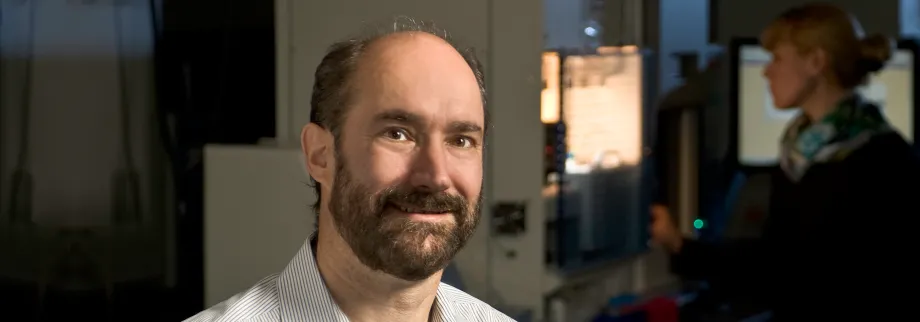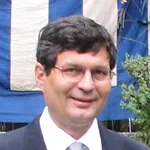
Photo by Steve Fisch: Michael Snyder and his colleagues found that autism may be linked to a defect in communication between the two halves of the brain.
Stanford Medicine News Center - December 30th, 2014 - by Krista Conger
A defect in communication between the two halves of the brain may be responsible for some cases of autism, according to a study by researchers at the Stanford University School of Medicine.
They came to their conclusions by analyzing what's called the human interactome — a vast network of interacting proteins - and by sequencing genomes and analyzing gene expression patterns in individuals with autism.
The study offers a possible explanation as to why the communication center of the brain, called the corpus callosum, is often abnormally small in people with the condition. Although most research has focused on neurons, this study also implicates the oligodendrocytes in the disorder. Oligodendrocytes coat the signaling arms of a neuron with an insulating substance called myelin, which enables electrical signals to move quickly from one neuron to another.
"This is our first glimpse of autism's underlying biological framework, and it implicates a cell type and region of the brain that have not been extensively studied in this disease," said Michael Snyder, PhD, professor and chair of genetics. "Until now, we've suspected that autism could be the result of defects in the neurons themselves. Now it appears that the oligodendrocytes can contribute to the problem by inhibiting neuronal signaling through poor cellular differentiation and myelination."
Snyder, who is also the Stanford W. Ascherman, MD, FACS, Professor in Genetics, is the senior author of the study, published online Dec. 30 in Molecular Systems Biology. Postdoctoral scholar Jingjing Li, PhD, research assistant Minyi Shi and research associate Zhihai Ma share lead authorship of the study.
Module 13
The researchers didn't directly analyze cellular functions in the corpus callosum. Instead, they layered many different types of previously published information about proteins in the brain — those that physically interact with one another, those that are found in similar regions of the brain and those that work in the same pathway or physical process — with mutations found in people with autism. The overlap led them to a group of 119 proteins involved in how nerve cells communicate.
"This protein interaction module contained genes involved in the development and function of oligodendrocytes in the corpus callosum, which directly supports the idea that autism might be due to poor connectivity between brain hemispheres," Li said.
Specifically, the researchers first took the publicly available data about the human protein interactome, which includes information about more than 69,000 protein interactions. They then used an algorithm to divide the interactome into 817 tightly associated subgroups of proteins. Members of these subgroups, or modules, were much more likely to physically associate with one another than with proteins outside their modules.
The researchers then searched among the 192 modules that contained more than five proteins and identified 85 in which many of the proteins were working together to accomplish specific biological tasks, such as adding a chemical tag to DNA-packaging proteins or tagging proteins in a signaling cascade with phosphate molecules. One module, module 13, included many proteins involved in the process of synaptic transmission — the process by which neurons communicate with one another across gaps between cells.
Finally, they examined all the proteins of the 85 modules for overlap with any of the proteins encoded by 383 previously identified autism-associated genes. Although proteins encoded by autism-associated genes could be found in many of the modules, module 13 stood out. It included significantly more autism-associated proteins than would be expected by happenstance: Twenty-one percent of the 119 proteins in module 13 had been previously associated with autism.
Sequencing genomes and exomes
To confirm their findings, the researchers sequenced the complete genomes of six people with autism and the partial genomes, or exomes, of an additional 19 individuals with the condition. The sequencing revealed 38 genes in module 13 that were significantly mutated. Twenty-eight of these mutations had not been previously associated with autism, and 10 of the 28 had been shown in mice to affect behavioral traits or nervous system function.
The researchers consulted the Allen Human Brain Atlas, a kind of three-dimensional map of gene expression, to determine where the genes for the proteins in module 13 are expressed. Although half the genes are expressed throughout the brain, the other half are more specifically expressed in the corpus callosum. The co-expression of both halves of the module in the corpus callosum was further confirmed using frozen, postmortem brain samples, indicating it's active in that region. Because oligodendrocytes are major cellular constituents of the corpus callosum, this study further implicated the involvement of module 13 in oligodendrocytes differentiation and myelination.
"These findings tell us that we may have to focus our attention on genes involved in different cell types and brain regions, rather than those that had initially raised the suspicions of autism researchers," Li said.
Exciting advance
Finding a new set of autism-associated genes is an exciting advance in the field of autism research, but it won't necessarily lead immediately to new therapies for people with the condition, said Joachim Hallmayer, MD, an associate professor of psychiatry and behavioral sciences and a co-author of the study.
"Autism is an extremely heterogeneous disease," Hallmayer said. "Many genes have been implicated, but environment also plays a role. This study suggests a possible way to subdivide patients into smaller, more homogenous populations based on which genes are mutated. Some of these may be very easy to treat, based on their mechanism, while others may be much more difficult. For those in this category, it's possible we could one day find a way to train or improve the connection between the brain's hemispheres."
Other Stanford co-authors are assistant professor of psychiatry and behavioral sciences Alexander Urban, PhD; pathology resident Jennifer Ziskin, MD, PhD; DNA sequencing program director Ghia Euskirchen; and life science research assistant Shuchun Zhao.
The research was funded by the National Institutes of Health (grant 1P50HG00773501).
Information about Stanford's Department of Genetics, which also supported the work, is available at http://genetics.stanford.edu



